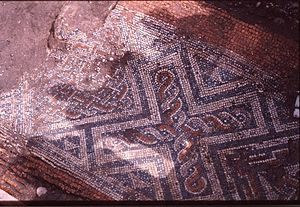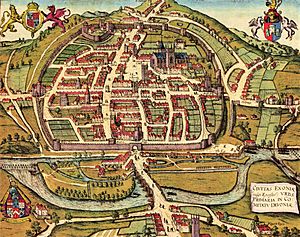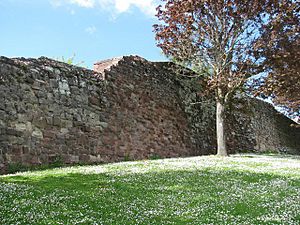Isca Dumnoniorum facts for kids
Isca Dumnoniorum, often called just Isca, was a Roman fortress and later a town. It was built by the Roman army around 55 AD in what is now Exeter, Devon, England. This important site was home to the Second Augustan Legion.
Over time, a town grew around the fortress. It became the main city, or capital, for the Dumnonians, a local Celtic tribe. This was true both during and after the Roman period. Today, the old city walls of Exeter show where Isca used to be. About 70% of these ancient walls are still standing.
Contents
Understanding the Name Isca Dumnoniorum
The name Isca Dumnoniorum comes from a Latin version of a local Celtic word. This word described "flowing water," referring to the River Exe. It likely meant "full of fish" originally. For example, the Welsh word for fish is pysg.
Later, the word simply meant "water." This is similar to how the word "whisky" relates to water. The modern Welsh name for Exeter, Caerwysg, also shows this. It means "fortified settlement on the river Uisc."
A similar name was used for the River Usk in southern Wales. To avoid confusion, the Roman settlement there was called Isca Augusta. The one in Devon was called Isca Dumnoniorum, meaning "Usk of the Dumnonians."
History of Isca Dumnoniorum
Early Settlements in Isca
Exeter was a good place for early settlements. It was on a dry ridge overlooking a river full of fish. The land nearby was also very fertile. While there haven't been many major prehistoric discoveries, these advantages suggest people lived here early on. Some ancient coins from the Hellenistic period (around 250 BC) were found. This suggests the area might have traded with the Mediterranean. However, some experts disagree about these coin finds.
Roman Fortress and Town

The Roman Fortress
After their first attacks on Britain, the Romans built a large fort in Exeter around 55 AD. This fort was about 42 acres in size and shaped like a playing card. It was the base for the Second Augustan Legion, which had about 5,000 soldiers. They stayed there for about 20 years. Then, they moved to Isca Augusta (modern Caerleon in Wales).
Families of the soldiers also lived near both Isca forts. Settlements likely grew outside the fort gates, especially to the northeast. Buildings inside the fort were mostly made of timber. These included barracks, granaries, and workshops. Archaeologists found traces of these buildings in the 1970s.
The only stone building in the fort was a military bathhouse. Water for the bathhouse came from a natural spring through an aqueduct. This aqueduct entered the fort through its back gate. Excavations showed parts of the hot room and warm room. The bathhouse also had an outdoor exercise yard.
The Second Augustan Legion was part of the Roman invasion of Britain in 43 AD. Vespasian, who later became emperor, led campaigns against local tribes. A dolphin-shaped roof fitting found in the bathhouse dates to about 60 AD. This fitting looks like one from the legion's later fort in Caerleon. This helps confirm the legion's presence in Exeter.
There was also a smaller fort nearby at Topsham. A supply depot was found between the Isca fort and Topsham in 2010. It was used at the same time as the Isca fortress, from about 55 to 75 AD. Another Roman fort was found in 2019 near the coach station.
The Roman Settlement
The town of Isca Dumnoniorum grew around the Roman fortress. It was one of four main cities listed by Claudius Ptolemy in his 2nd-century book Geography. It served as the capital city for the Dumnonii. Isca was also mentioned in the Antonine Itinerary, a Roman road guide from the late 2nd century.
The Roman army left the fortress around 75 AD. Soon after, the land was used for civilian purposes. The military baths were too big for the townspeople. They were mostly taken down, but some parts were used for the new forum and basilica. A smaller bathhouse was then built nearby.
In the late 2nd century, the fort's old defenses were replaced. A new bank and wall were built around a much larger area, covering about 92 acres. There is proof of copper and bronze working in the town. Isca was also an important market for animals, crops, and pottery from the surrounding area.
Over a thousand Roman coins have been found in the city. This shows how important Isca was for trade. The coins suggest the city was most successful in the early 4th century. However, very few coins from after 380 AD have been found. This means the city likely declined quickly after that time.
Isca in Medieval Times

After the Roman withdrawal from Britain around 410 AD, there is little evidence of people living in Exeter for almost 300 years. Some remains of a building, possibly a church, and a few graves from the 5th to 7th centuries have been found.
History picks up again around 680 AD. A document from that time says that St Boniface was educated at an abbey in Exeter.
What Remains of Isca Dumnoniorum Today
Much of the original Roman wall still exists. It forms the lower parts or inner core of Exeter's medieval city walls. About 70% of these walls are still standing. Alfred the Great largely ordered their construction to protect his kingdom from Viking attacks in 876 AD.
The Roman legionary bath complex was dug up in the 1970s. Because it was so close to the cathedral, it could not be kept open for public viewing. However, many items found during the excavation are on display. You can see them, along with other discoveries, at Exeter's Royal Albert Memorial Museum.
See also
 In Spanish: Isca Dumnoniorum para niños
In Spanish: Isca Dumnoniorum para niños



